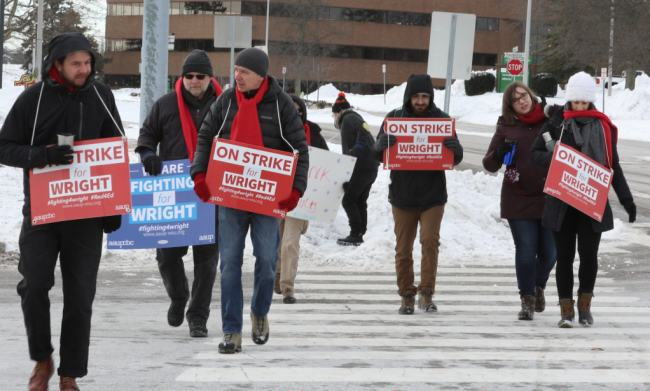You have /5 articles left.
Sign up for a free account or log in.

After failing to reach an agreement with their administration over newly imposed working conditions, including a furlough policy, the Wright State University faculty union started a threatened strike Tuesday.
Wearing the union-advised dress code of “layers, layers, layers,” dozens of professors faced winter morning weather to picket starting at 8 a.m. Their ranks grew over the course of the day. Many students came to show support. Many others attended classes as usual.
The university said in a statement that 40 percent of American Association of University Professors-affiliated faculty members at its main Dayton, Ohio, campus were teaching their classes or planned to. Some 53 percent of AAUP-represented professors were teaching or would be teaching at the Lake campus, it said.
Some 80 percent of Wright State classes taught by AAUP-affiliated faculty members “were held without issue,” according to the university. Wright State “is committed to providing our students with a high-quality, affordable education,” President Cheryl B. Schrader said. “This is our contract with students, and it is nonnegotiable.”
The union took issue with that kind of characterization on social media, highlighting generic university directions to students without instructors to visit the library and complete modules or attend guest lectures.
Wright State’s faculty union has been without a contract for two years, due to protracted negotiations. The university has indicated that its hands are tied as it seeks to rein in historical overspending, including via a $53 million budget reduction last fiscal year. The union, meanwhile, has blamed any budget crisis on the board’s noninstructional expenditures, such as new campus housing units and million-dollar settlements in federal cases alleging that Wright State secured student visas for nonstudent area employees and paid loans to nonconfirmed students.
“Wright State’s administration has spared no expense when it comes to protecting themselves from the consequences of their actions. Now that the bill has come due, their answer is to dilute the quality of Wright State’s education with more classes per teacher and less time for research. Enough,” Marty Kich, professor of English and president of the Wright State AAUP chapter, said in a statement.
Other union talking points are that full-time teaching salaries make up just 17 percent of the budget and that there has been a net loss of 92 full-time instructors since 2016. So Wright State's problems can't be solved on the backs of the faculty, no matter how hard the university tries, the union says.
Even though the university has managed to avoid a state-imposed fiscal watch while under the last faculty collective bargaining agreement, “we do recognize that we will have to take a financial hit on this contract,” the union’s executive committee wrote in a memo to members, advising that they vote to strike. “What we are objecting to is that the people who created the mess are now trying to gut our contract by using the mess that they created as a justification.”
The union says its previous attempts to negotiate on those grounds were rebuffed.
“The administration still refuses to talk with us,” Rudy Fichtenbaum, professor of economics at Wright State and president of the national AAUP, said on the eve of the strike.
‘Last Best Offer’
The campus AAUP chapter ultimately did vote to strike after the university’s Board of Trustees approved a “last best offer” -- what the union calls an imposed contract -- earlier this month.
That offer included no pay raise, similar to five of the last eight years. It canceled existing workload agreements and gave deans and chairs discretion over merit pay in lieu of a formula, in a loss for transparency, according to the union. The contract also increased the eligibility period for non-tenure-track faculty members to win continuing appointments from six to nine years. The current six-year period parallels typical tenure timelines elsewhere.
The union estimates the latter change would impact at least 60 current employees and asserts that it threatens academic freedom, since instructors will have less of it with less job security. It also says that the new timeline for eligibility for these continuing appointments is effectively 12 years, since the board's last best offer says that eligibility means nine or more years of service and appointment or promotion to the rank of senior lecturer or clinical assistant professor.
The board-approved conditions include additional changes to professors’ health care and their rights to summer teaching assignments, all of which union leaders reject.
Perhaps most controversially, the board approved a new furlough policy, which the union says could be unlimited as written.
“We cannot measure how much income you might lose, because the board’s recommendation that cost savings days be limited to two per semester is not in the imposed contract,” the union’s executive committee wrote in its strike recommendation to members. “Since the imposed contract requires that cost savings days be implemented ‘in a manner that does not interrupt academic … functions,’ you will be forced to work without pay.”
Gretchen McNamara, a senior lecturer of music who teaches trombone at Wright State, wrote in a widely shared Facebook post that she began teaching on campus in 2007, terminal degree in hand, for $31,000. Unionization of non-tenure-track faculty and personal advocacy for comparable pay to others in her department eventually landed her a continuing appointment, promotions and the opportunity to max out the pay scale at a $59,000 annual salary. Now, she says, those gains are at risk -- not, in her opinion, because the university can’t afford them, but because it’s trying to grab power.
“If we accept this imposed contract, the administration will have effectively taken away our right to bargain over our terms and conditions of employment,” she wrote. “It’s time to stand up and fight.”
The strike resumes today.





